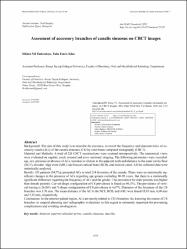| dc.contributor.author | Tomrukçu, Dilara Nil | |
| dc.contributor.author | Köse, Taha Emre | |
| dc.date.accessioned | 2020-12-19T19:35:24Z | |
| dc.date.available | 2020-12-19T19:35:24Z | |
| dc.date.issued | 2020 | |
| dc.identifier.citation | Tomrukçu, D. N., & Köse, T. E. (2020). Assesment of accessory branches of canalis sinuosus on CBCT images. Medicina oral, patologia oral y cirugia bucal, 25(1), e124–e130. https://doi.org/10.4317/medoral.23235 | en_US |
| dc.identifier.issn | 1698-6946 | |
| dc.identifier.uri | https://doi.org/10.4317/medoral.23235 | |
| dc.identifier.uri | https://hdl.handle.net/11436/1285 | |
| dc.description | WOS: 000541535900015 | en_US |
| dc.description | PubMed: 31880280 | en_US |
| dc.description.abstract | Background: the aim of this study is to describe the presence, to reveal the frequency and characteristics of accessory canals (ACs) of the canalis sinuosus (CS) by cone beam computed tomography (CBCT). Material and Methods: A total of 326 CBCT examinations were scanned retrospectively. the anatomical views were evaluated on sagittal, axial, coronal and cross sectional imaging. the following parameters were recorded: age, sex, presence or absence of ACs, location in relation to the adjacent teeth and distance to the nasal cavity floor (NCF), alveolar ridge crest (ARC) and buccal cortical bone (BCB), and incisive canal. All the collected data were statistically analyzed. Results: 113 patients (34,7%); presented ACs in total 214 foramina of the sample. There were no statistically significant changes in the presence of ACs regarding age groups excluding 80-89 years. But there is a statistically significant difference regarding the frequency of ACs and the gender. the prevalence for male patients was higher than female patients. Curved-shape configuration of CS prevalence is found as 69,15%. the prevalence of vertical tracing is 26,16% and Y-shape configuration of CS prevalence is 4,67%. Diameter of the foramens of the CS branches was 1.30 mm. the mean distance of the AC to the NCF, BCB, and ARC were found 13,83 mm, 6,60 mm and 5,32 mm, respectively. Conclusions: in the anterior palatal region, ACs are mostly related to CS's branches. So; knowing the course of CS branches in surgical planning and radiographic evaluations in this region is extremely important for preventing complications and avoiding misdiagnosis. | en_US |
| dc.language.iso | eng | en_US |
| dc.publisher | Medicina Oral S L | en_US |
| dc.rights | info:eu-repo/semantics/openAccess | en_US |
| dc.subject | Anterior superior alveolar nerve | en_US |
| dc.subject | Canalis sinuosus | en_US |
| dc.subject | Maxilla | en_US |
| dc.title | Assesment of accessory branches of canalis sinuosus on CBCT images | en_US |
| dc.type | article | en_US |
| dc.contributor.department | RTEÜ, Diş Hekimliği Fakültesi, Klinik Bilimler Bölümü | en_US |
| dc.contributor.institutionauthor | Tomrukçu, Dilara Nil | |
| dc.contributor.institutionauthor | Köse, Taha Emre | |
| dc.identifier.doi | 10.4317/medoral.23235 | |
| dc.identifier.volume | 25 | en_US |
| dc.identifier.issue | 1 | en_US |
| dc.identifier.startpage | E124 | en_US |
| dc.identifier.endpage | E130 | en_US |
| dc.ri.edit | oa | en_US |
| dc.relation.journal | Medicina Oral Patologia Oral Y Cirugia Bucal | en_US |
| dc.relation.publicationcategory | Makale - Uluslararası Hakemli Dergi - Kurum Öğretim Elemanı | en_US |


















